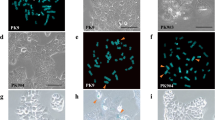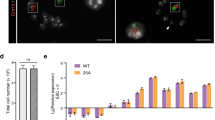Abstract
IN spite of extensive investigations of the process of carcinogenesis in vitro, the basic mechanisms of the primary events are poorly understood1. In general, it is found that the first manifestation of the transformed phenotype involves morphological alteration of the cells. This is usually followed by an ill-defined process resulting in several further changes in phenotype including the ability of the cells to grow in agar (aga+), and to produce tumours in animals. In part because of the variety of phenotypes observed, but also because of the lack of suitable methods of analysis, it has been difficult to examine the process of transformation at the genetic level. We have recently initiated experiments designed to use chromosome transfer techniques to attempt such a genetic analysis2,3 and work in several laboratories has shown that single gene markers can be transferred from cell to cell at frequencies of 10−6–10−7 by means of the metaphase chromosome4–9. Most of the initial work was done with the genes for hypoxanthine phosphoribosyl transferase and thymidine kinase, but dominant markers such as resistance to methotrexate and ouabain can also be so transferred9, as can the wild-type alleles for three auxotrophic markers10. In seeking to delineate the genetic elements of carcinogenesis, we have examined the ability of purified metaphase chromosomes from Chinese hamster ovary (CHO) cells to transfer the first recognisable phenotype observed during cell carcinogenesis, that is, morphological transformation. Because of the low frequency of chromosome transfer, an appropriate method for selection of cells (transferents) which have incorporated the relevant markers from the background of recipient cells is necessary. Our experiments were based on the assumption that if transformation gene(s) could be transferred to senescent cells, then they should be able to produce colonies, whereas the majority of the cells which do not receive the appropriate marker, will not form colonies. The results presented here show that senescent hamster cells can be rescued and become transformed by transfer of purified metaphase chromosomes from CHO cells; the frequency of this event is similar to that of single gene markers.
This is a preview of subscription content, access via your institution
Access options
Subscribe to this journal
Receive 51 print issues and online access
$199.00 per year
only $3.90 per issue
Buy this article
- Purchase on Springer Link
- Instant access to full article PDF
Prices may be subject to local taxes which are calculated during checkout
Similar content being viewed by others
References
Heidelberger, C. A. Rev. Biochem. 44, 79–121 (1975).
Spandidos, D. A. & Siminovitch, L. Cell (in the press).
Spandidos, D. A. & Siminovitch, L. Brookhaven Symp. Biol. 29 (in the press).
McBride, O. W. & Ozer, H. L. Proc. natn. Acad. Sci. U.S.A. 70, 1258–1262 (1973).
Burch, J. W. & McBride, O. W. Proc. natn. Acad. Sci. U.S.A. 72, 1797–1801 (1975).
Willecke, K. & Ruddle, F. H. Proc. natn. Acad. Sci. U.S.A. 72, 1792–1794 (1975).
Wullems, G. J., Van der Horst, J. & Boostma, D. Somatic Cell Genet. 1, 137–152 (1975).
Degnen, G. E., Miller, I. L., Eisenstadt, J. M. & Adelberg, E. A. Proc. natn. Acad. Sci. U.S.A. 73, 2838–2842 (1976).
Spandidos, D. A. & Siminovitch, L. Proc. natn. Acad. Sci. U.S.A. 74, 3480–3484 (1977).
Spandidos, D. A. & Siminovitch, L. Cell 12, 235–242 (1977).
Stanners, C. P., Elicieri, G. L. & Green, H. Nature new Biol. 230, 52–54 (1971).
Author information
Authors and Affiliations
Rights and permissions
About this article
Cite this article
SPANDIOS, D., SIMINOVITCH, L. Transfer of the marker for morphologically transformed phenotype by isolated metaphase chromosomes in hamster cells. Nature 271, 259–261 (1978). https://doi.org/10.1038/271259a0
Received:
Accepted:
Published:
Issue Date:
DOI: https://doi.org/10.1038/271259a0
This article is cited by
-
The role of oncogenes and onco-suppressor genes in carcinogenesis
Chinese Journal of Cancer Research (1989)
-
A unified theory for the development of cancer
Bioscience Reports (1986)
-
Parameters governing the transfer of the genes for thymidine kinase and dihydrofolate reductase into mouse cells using metaphase chromosomes or DNA
Somatic Cell Genetics (1980)
-
Increased cyclic AMP content directly correlated with morphological transformation of cells infected with a temperature-sensitive mutant of mouse sarcoma virus
In Vitro (1980)
Comments
By submitting a comment you agree to abide by our Terms and Community Guidelines. If you find something abusive or that does not comply with our terms or guidelines please flag it as inappropriate.



